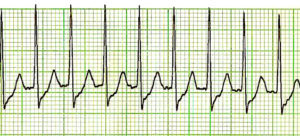 Normally, we hardly notice our heart beating away diligently in our chest. Surprising, because the mere fact that it is beating is the reason we are alive. Once in a while, when we are scared or excited, or after a round of exercise we may feel it pounding strongly.
Normally, we hardly notice our heart beating away diligently in our chest. Surprising, because the mere fact that it is beating is the reason we are alive. Once in a while, when we are scared or excited, or after a round of exercise we may feel it pounding strongly.
Doctors usually describe the heartbeats according to its rate, rhythm and character. A normal person has a resting heart rate of around 60-100 beats per minute. Athletes may have even lower heart rates than that. The rhythm is normally regular, you can feel your own pulse and notice this for your selves.
The heart generates its own electrical impulses via special cells known as pacemaker cells, and transmits this impulse to other cells in the heart along a specific pathway resulting in normal contraction of the heart muscles. This allows the heart to serve its function to pump blood carrying oxygen to our whole body. These impulses occur when there is passage of different concentrations of various ions in and out of cells such as sodium ions, potassium ions and calcium ions.
Arrhythmias, as the name suggests, are abnormal rhythms of the heart. It occurs either as due to an abnormality in the formation of impulse or due to an abnormality in the impulse conduction, or both. Patients with arrhythmia often present with palpitations or an awareness of their own fluttering heartbeat, racing heartbeat, chest pain or shortness of breath.
There are many factors that can induce arrhythmias including decreased oxygen to the heart muscles, abnormal levels of electrolytes or hormones, drug toxicity, presence of scarred or diseased heart tissue and various other conditions.

Anti-arrhythmic drugs aim to reduce abnormal production of impulses and modify conduction abnormalities. There are 4 major classes of drugs used to treat arrhythmias based on their main mechanisms of action. There are also miscellaneous drugs which do not fall into these categories.
| Class I | Class II | Class III | Class IV | |
| Mechanism of action | Sodium channel blocker | Beta- blockers | Potassium channel blocker | Calcium channel blocker |
| Examples | Quinidine
Lidocaine Flecainide |
Propanolol
Esmolol |
Amiodarone
Sotalol |
Verapamil
Diltiazem |
It is important to remember that all anti-arrhythmic drugs may also cause different types of arrhythmias and other adverse effects. Patients must take the drugs as prescribed by the doctor as well as adhere to other instructions given. Always inform your doctor if you are taking other medication or supplements as it may interfere with the anti-arrhythmic drugs.
The doctors will diagnose the specific form of arrhythmia each patient is having based on the history, physical examination and investigations such as ECG; determine the underlying cause and weigh the risks and benefits of each type of medication before starting the patient on any drug therapy.
Dr Hidayatul Radziah Ismawi is a medical doctor, pharmacologist and lecturer at the International Islamic University Malaysia. She obtained her PhD in Medical Sciences (Pharmacology) earlier this year. Her research interests include hypertension and cardiovascular diseases. She is also the Chief Editor of MMG.
References
-
Lippincott’s Illustrated Reviews (5thEd)
[This article belongs to The Malaysian Medical Gazette. Any republication (online or offline) without written permission from The Malaysian Medical Gazette is prohibited.]
